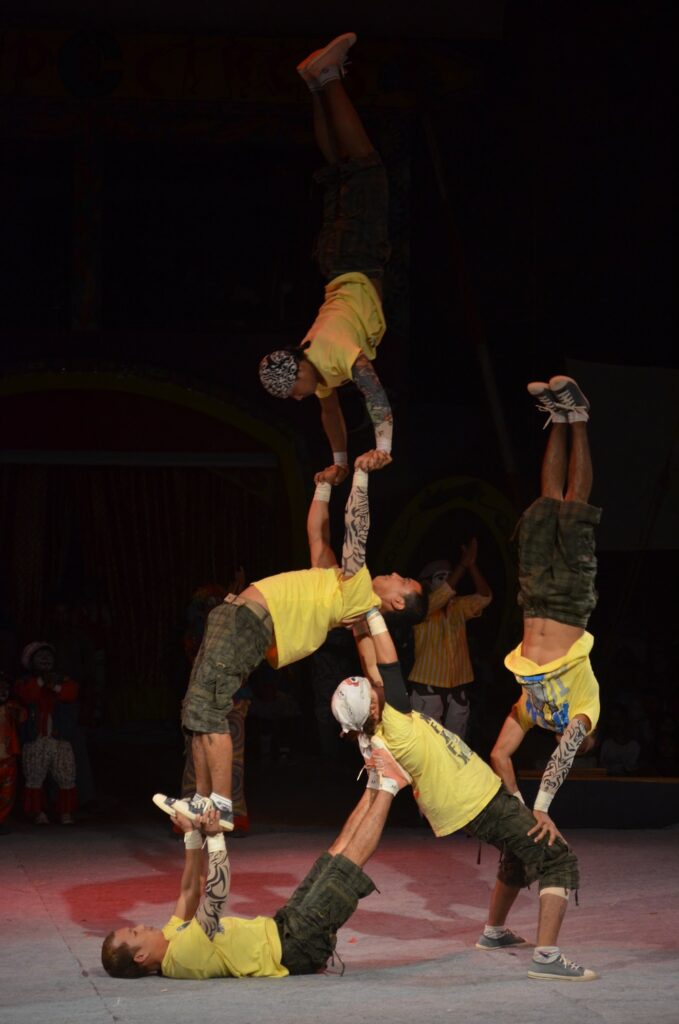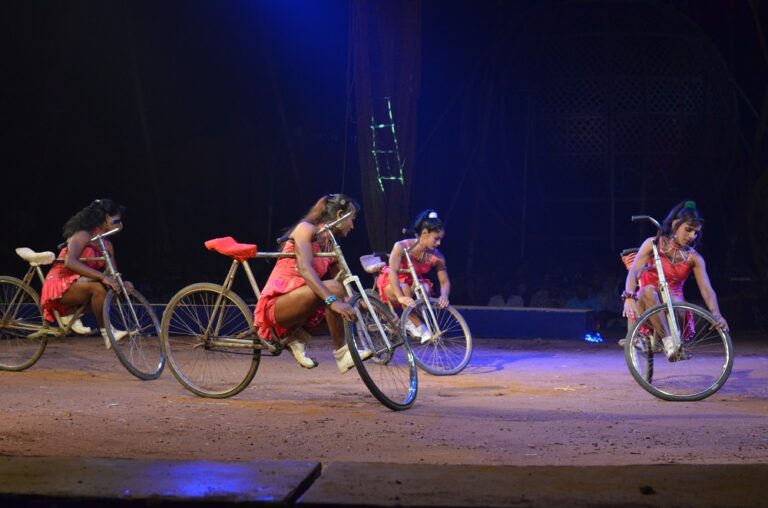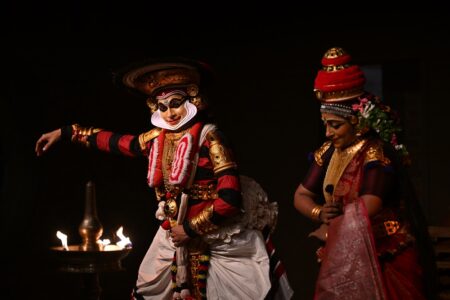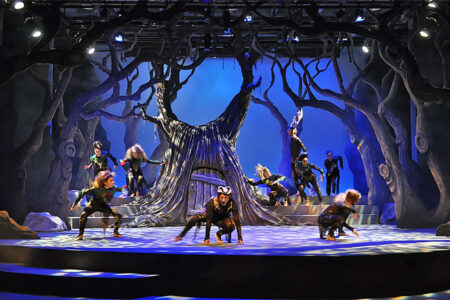What did the artistes do when the audience disapproved of the integration of theatre and circus on stage?
In December 2011, we hosted the premier show of our circus play ‘Clown and Clouds’, performed by Second-Year students at the National School of Drama. All the efforts seem to have come to fruition. The performance took place on the lush green Marine Ground at Kozhikode, Kerala from 17-19 December. From 4-10 January 2012, the artistes and students performed at the Indira Gandhi National Centre for the Arts (IGNCA) in New Delhi.
Under my direction and guidance, the NSD students alongside the circus artistes executed the project with sincerity and dedication. However, not everything went as expected. This new creation could not click as we had hoped because the people thronged to the venue, say about 3,500 of them per day, expected to watch a circus show. However, viewers were probably disappointed to see a show that was an amalgamation of theatre and circus.
The reception to the new concept
For starters, the audience response in Kerala was not encouraging. The performance commenced at 7:00 p.m. and the on-lookers were generally small traders, fishermen and others to whom Hindi dialogues without any Malayalam translation were Greek and Latin.
Unfortunately, the situation became uncontrollable with hooting, howling, throwing slippers, etc., along with expletives and aggressive opposition. Some even shouted that they wanted to see girls in revealing costumes and not the curated piece which we had painstakingly put up on the stage.
Out of the blue, both circus authorities and NSD-ites changed the script. Instead of showing the dialogue-oriented drama scenes, they presented a mixture of attractive circus items, choreographic ensembles and musical visuals. The theatre pieces were completely removed. This mixture of items somehow proved palatable to the audience. Probably this was the first time an effective, on-the-spot editing was done in my theatre career.
That night probably for the first time the circus artistes reacted and shared their pains. It was disheartening for them that most of the circus audience wants to “see our body and our skin and they are never interested to see our story or what we are actually going through in the circus tents”.
Some of the NSD students cried and some of the circus artistes were very sad and depressed. It was difficult to face my students, it was difficult to face the circus artistes, it was difficult to face my friends, my parents who had travelled in their old age all the way from Thiruvananthapuram to see the show, it was difficult to face my well-wishers, it was difficult to face my co-artistes who were working round-the-clock to make this project happen. It was a dark phase for me. And some of the purist artistes in theatre rejoiced in my agony and went so far as to comment that “theatre should be theatre and circus should be circus”.
In the light of these events, the next day, some of the theatre parts were removed and the remaining portions presented. In short, the circus items were shone under the new lighting design of Sreekanth along with the lively dances, short theatre scenes and other projections of video installations. This combination proved to be beautiful, entertaining and interesting. After two days of production experience, and the lessons learnt, on Day 3, the presentation was smooth and enjoyable.

Even though the complete play could not be presented, most of the drama scenes and theatre parts were presented without much difficulty and disturbances. On that day, it was a direct communication with the audience and the show made them understand the thematic inputs in a simplistic and artistic manner.
Processes important, not product
Going forward, despite the difficulties in executing such an exercise, the spectators were informed well in advance that they would not be viewing an ordinary circus. The audience were made aware that they would see the presentation as a part of training of the theatre students and an experiment undertaken by NSD students as well as artistes of the Grand Circus.
The male and female actors appeared in the roles of jokers welcomed the spectators and interacted with them in a jovial manner. The organisers too appreciated the gesture. It was a learning process for me too – as I learnt that if audience has purchased tickets with the expectation of viewing a popular art form and if something different is shown, then their hopes and expectation is shattered. And in the process, they may not appreciate the alternative they have been shown despite all the hard work gone into the presentation.
The revised show
‘Clown and Clouds’ was later presented in Delhi during January 2012 as part of students’ production and put up in its totality as envisaged in Kozhikode. It was watched by more than 2,500 people daily for eight days. Whatever may be the outcome of the project, everyone knew this was the first time anyone ventured into blending and exhibiting circus items and theatre pieces in a circus tent in the history of both Indian circus and Indian theatre.
A different performing art was created, and it was quite an adventurous exercise. Also, this production taught some good lessons not only to the circus and theatre artistes but also to the audience. Although initially the organisers were apprehensive that the audience would not accept such an off-beat visual treat, later they genuinely pitched in to prepare the audience mentally so that everyone could enjoy the programme peacefully.
As part of Second-Year students’ theatre syllabus, I hope, this project helped infuse confidence, maturity, experience and expertise among the students. This, to me, was one of the creditable features of this project. Here, I would like to emphasise that ‘process was important not the product’ to the students.
Within a short span of a month-and-a-half, these young artistes embraced their new work most sincerely, emotionally and effectively. They worked hard and rose to the occasion every time there was a hurdle. This experience also boosted their confidence in exploring other performing arts beyond theatre.
The project and after…
Sherith, son of Chandran of Grand Circus, formed a new circus company named Global Circus with a hope that a new kind of circus movement can emerge in the circus industry. With the NSD’s collaboration and their presence in the campus of Grand Circus, they were able to garner enough publicity in the local dailies regarding this joint project in November and December.
Besides, the company could make a good profit as most of the days it was ‘houseful’ as the audience were curious to see the new shows at Grand Circus. A week before commencing the regular circus shows, installations of modern lights and sound equipment were done in the circus tent. The entire technology became another attractive feature in the total visuality of the shows of Grand Circus.
Along with the modern technology, narrational story elements and the effective physical theatre visuals presented a new performing phenomenon not only to the circus artistes but also to the audience. Sherith’s Global Circus has also been continuously in touch with us at the NSD to start another project where we have been contemplating giving an acting workshop to the circus artistes. This would probably help them develop a new narrative to their circus items.
Click here to read more
Write to us at editor@indiaartreview
Photo Courtesy: Priyanka Pathak




